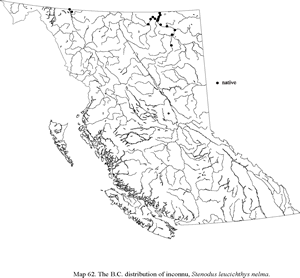The distribution of inconnu in B.C. is disjunct — there is a freshwater-resident population in Teslin Lake and a migratory population in the Liard River system. The Liard population is biologically complex: some individuals appear to be part of the general upper Mackenzie River population and probably isn’t anadromous but other individuals are known to migrate to the Mackenzie Delta, and others tagged individuals have been taken in the Beaufort Sea. There is some evidence that some of the Liard population breeds in B.C.; however, no fry have been collected in B.C. although one juvenile was collected in the Ft. Nelson River. In contrast, the Teslin Lake population is thought to breed in the lake and appears to be isolated from the migratory Yukon populations. As far as is known, the Teslin population is the only lacustrine population in the Yukon system. In itself, this makes it unusual. Additionally, all the Yukon populations appear to be separated from the Mackenzie populations by a substantial distributional gap along the north coast of Alaska. This suggests that the two B.C. groups of Stenodus may be genetically different. The Teslin Lake population really needs study.
Source: Information provided by Don McPhail for E-Fauna BC.
North America and Asia: Arctic drainages from Anderson River in Northwest Territories, Canada to Kuskokwim River (Bering Sea tributary) in Alaska. Upstream in Mackenzie River and Yukon River drainages to British Columbia, Canada. Isolated population occurs in northern Caspian Sea and inflowing rivers (Ref. 1998). Populations from Kazakhstan, Russia and probably Azerbaijan are endangered (Ref. 12255). Hybridization with Coregonus nelsoni, Coregonus autumnalis and Coregonus muksun are due more to the broadcasting of eggs and sperm rather than pairing between species or genera (Ref. 27547).
Source:
FishBase. Svetovidov, A.N. 1984 Salmonidae. p. 373-385. In P.J.P. Whitehead, M.-L. Bauchot, J.-C. Hureau, J. Nielsen and E. Tortonese (eds.) Fishes of the north-eastern Atlantic and the Mediterranean. UNESCO, Paris. Vol. 1.

